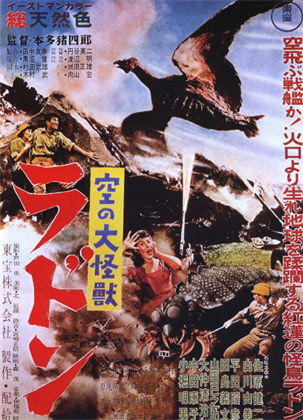
“The Pteranodon is the largest flying species recorded in our history. According to the computer calculation from its egg-shell, this one – we named it ‘Rodan’ – has a 270-foot wing-span…”
[Original title: Sora No Daikaiju Radon (Giant Sky Monster Radon)]
Director: Honda Ishirō
Starring: Sahara Kenji, Shirakawa Yumi, Hirata Akihiko, Kobori Akio, Imaizumi Ren, Yamada Tatsunosuke, Tajima Yoshifumi, Takagi Kiyoshi, Mizunoya Kiyomi, Matsuo Fumihito, Kisaragi Kanta, Suzukawa Jirô, Ogata Rinsaku
Screenplay: Murata Takeo and Kimura Takeshi, based upon a story by Kuronuma Ken
Synopsis: At a colliery near Mt Aso on Kyushu, miners must break up a fight between Yoshizo (Suzukawa Jirô) and Goro (Ogata Rinsaku): one of several recent conflicts between the two. The antagonists join their fellow workers on the morning-shift, and descend into the mine. At the operations centre, engineer Kawamura Shigeru (Sahara Kenji) is alerted that one of the mine shafts has flooded. He hurries over to inspect the situation and learns that, while no-one has been injured, Yoshizo and Goro are missing. The rest of the crew is trying to pump out the shaft; Shigeru leads three of the miners through the waist-deep water within the pit, to try and find its source. Instead they find Yoshizo’s body… Medical examination suggests that Yoshizo’s fatal head injury was inflicted with a knife, although Dr Minakami (Takagi Kiyoshi) is puzzled by the wound. Shigeru urges the other miners not to jump to conclusions about Goro’s involvement, nor to spread rumours, but to wait for the investigation. However, he soon discovers that talk has already reached the ears of Kiyo (Shirakawa Yumi), Goro’s sister; he expresses his own faith in Goro and urges her not to think the worst. Two miners lead a police officer into the pit, so that he can search for the missing Goro. Suddenly, two of the men are dragged down into the water; the third escapes only as far as an emergency telephone… The three dead men are found to have wounds similar to Yoshizo’s, with the police officer almost decapitated. There is bewilderment over how any weapon capable of inflicting these injuries could have been carried into the mine. That evening, Otami (Mizunoya Kiyomi), Yoshizo’s widow, tries in a fit of hysteria to force her way into Kiyo’s home, but is dragged away by the other miners’ wives, who argue that Kiyo has done nothing. Shigeru arrives to find Kiyo in tears—and as he comforts her, a huge, grotesque, caterpillar-like creatures plunges into the house. The two flee, shouting for help. The police and the mine guards respond, but the creature is impervious to gunfire. It does, however, retreat to the mountains, where two police officers are killed while trying to fight it. When the bodies are examined, they are found to be carrying some now-familiar injuries. Police Chief Nishimura (Kobori Akio) calls the army for reinforcements, and soon soldiers with light and heavy machine-guns are setting up posts along the mine-shaft; while Shigeru and Nishimura lead the search for Goro. The water in the pit has receded, and Shigeru does find Goro—dead like all the others… Suddenly, a caterpillar-monster attacks—and even machine-gun fire is ineffective. As the soldiers fall back, Shigeru has the idea to send a fully-laden coal-train down the tracks at the creature. The impact of the resulting collision severely injures the creature, which sinks into the water—only for another to appear out of the darkness. In trying to fight it, the soldiers start a rock-fall; the creature is crushed to death, but Shigeru is trapped…
Comments: Toho wasn’t slow in responding to the shot fired across its bow by Daiei with its release of Warning From Space. The studio would produce its own film about aliens soon enough – nasty invading aliens, not cute and friendly ones – and in the meantime, it made its first colour kaiju eiga; which was also only Toho’s second-ever colour film.
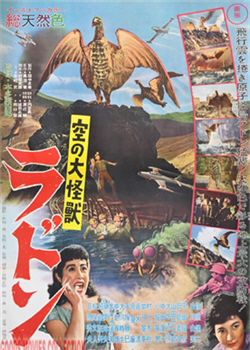


I have to admit that Rodan is a film I have some difficulty loving. I was particularly conscious of that on this viewing, trying to figure out what it is about it that leaves me “a bit cold around the heart”. Certainly its credentials could hardly be stronger, reuniting the Gojira team of producer Tanaka Tomoyuki, director Honda Ishirō, composer Ifukube Akira, special effects director Tsuburaya Eiji and suit-actor Nakajima Haruo; and with screenwriter Murata Takeo joined by newcomer Kimura Takeshi. Furthermore, Rodan maintains the serious tone and political underpinnings of Gojira and Godzilla’s Counterattack, while introducing two new monsters into the Toho roster.
Yet in those very credentials we might have the reason why Rodan leaves me a little cold. It feels like a movie made chiefly to one-up Daiei and re-establish Toho at the top of the monster-tree; and there is more of a sense here than there should be of going through the expected motions, at least once the action shifts away from the mine. The film just doesn’t bring enough fresh material to the table, not even in light of two new monsters, which aren’t sufficiently its focus. (Compare the way that Rodan and Meganulon are used here to the monster rumbles that justify the existence of Godzilla’s Counterattack.) Furthermore, while the film is serious enough, the desperate sincerity of Gojira is entirely absent.
One of the things that the film does do well is introduce an entirely new backdrop for its story. Rodan is set chiefly in the vicinity of Mt Aso, a volcano situated on the island of Kyushu, in the southern part of Japan. The volcano was and is active, and as with most such sites, the surrounding area is fertile and traditionally a farming district: something noted over the course of the film.
On the other hand, the coal mine that is the focus of much of Rodan’s action is fictional. We must note, however, that there is a political purpose here that may be lost upon modern / non-Japanese viewers. The film’s mine is based upon the Mitsui Miike coal mine in the western part of Kyushu, which in 1952 – 1953 was the site of a major strike which ultimately turned violent: something to which the inter-worker tensions that open the film may allude.

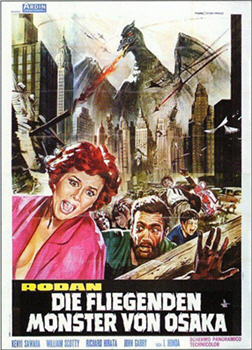

(There is also an accidental resonance in the film’s use of this particular coal mine: in 1963, the Mitsui Miike would become the site of the second-worst mining disaster in Japanese history, the worst of the post-war era.)
Typically, however, the most significant reason for the choice of Kyushu for this film’s setting is referenced in only the most oblique manner: situated upon the island’s northwest coast is the city of Nagasaki…
Rodan opens with a pan across the district, from the volcano to the coal-mine where, at the morning change of shift, the friends of miners Yoshizo and Goro are reacting to yet another fight between the two. We should perhaps note that after things have settled the first time, it is a silly gesture that from Yoshizo that sets the fight off again. Hence, tensions are still high when the antagonists must descend into the mine to begin their day’s work. Separately, the two men take their places on the train that will carry them down into the earth.
Up in the main offices of the mining concern, we are introduced to the young engineer, Kawamura Shigeru. His supervisor arrives shortly afterwards, stripping off his jacket and mopping the back of his neck:
Shigeru: “The earth is getting hotter.”
Supervisor: “You mean global warming?”
Wow. 1956. You’d think all those scientists who are “getting rich off this” would be rich by now, wouldn’t you?
A telephone call alerts the mine’s head office to a dangerous situation: one of the pits has suddenly flooded, though without anyone understanding where the water is coming from, or being able to pump it out.

Shigeru dons his safety gear and takes charge at the mine, where he learns that the men have managed to stop the influx of any more water. No injuries have been sustained by any of the miners, but to his dismay Shigeru learns that both Goro and Yoshizo are missing. He descends into the pit with a safety officer, selecting two of the miners to accompany them. Soon the four men are chest-high in water, but their attempt to determine the cause of the flood is abruptly cut short, when they discover Yoshizo’s body. Of Goro there is no sign…
The body is carried to the medical suite attached to the mine (the need for, effectively, a designated hospital onsite speaks to mining conditions at the time!), where it is cleaned and examined. Cause of death is found to be several vicious stab-wounds; though Dr Minakami is puzzled as to what sort of weapon could have inflicted them, particularly the head-wound. When he insists upon the police being summoned, he learns that Shigeru has already called them with respect to what was at first considered an accidental death.
Suddenly, there are wild cries out in the corridor. Shigeru and the other three men exit the medical suite, and must contend with Otami, Yoshizo’s wife – widow – who is trying to force her way in. The men assure her that her husband is being treated, and then slip away from the painful scene…
At this stage of the kaiju eiga it was unusual to have more than one important female character, and so it is with Rodan. However, the film does include the miner’s womenfolk in its general mise-en-scène, making the viewer aware of them as, so to speak, prisoners to the mine—occupying a cluster of company-built houses while their husbands and brothers undertake their dangerous work. We get a sense of mutual support amongst the women, though sadly, chiefly with respect to helping one another in moments of crisis and loss. Thus, we never see Otami except in the company of several other mining wives, who now comfort her while she wails in helpless grief in the hospital corridor.
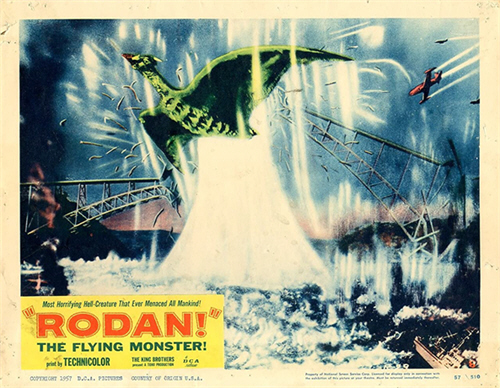
Outside, however, there is one woman who has been left in isolation. This is Goro’s sister, Kiyo, with whom Shigeru is romantically involved.
(Mind you, while I say that— We’re used to the “romance” at the heart of these Japanese films being downplayed, but the relationship between Shigeru and Kiyo is low-key to the point of, well, pointlessness.)
Shigeru hurries to Kiyo, who is being looked at askance and whispered about by some of the other women. He assures her that he has faith in Goro, and adds that she should have too. However—he also suggests that she stay at home until the matter is cleared up.
Two miners, Senkichi and Sute, guide a senior police officer down into the mine, helping him to search for the missing Goro past the point where Yoshizo’s body was found. As they wade through the water, they hear a strange sound up ahead…
Senkichi screams as something begins dragging him under the water, and the police officer soon suffers the same fate. The terrified Sute manages to free himself from the safety-line linking him to the others, and fights his way out of the water to an emergency phone; but he has only just made contact when something looms up out of the darkness…
And so three more bodies are soon being examined in the medical suite. They carry the same sorts of wounds as Yoshizo, but even more so: the police officer has almost been decapitated. The doctor speaks hesitantly of a sword, only to be assured that no such weapon could have been taken down into the mine.


Later, an hysterical Otami tries to confront Kiyo in her home, only to be grabbed and forced away by the other wives, who argue sensibly enough that whatever Goro may or may not have done, it has nothing to do with Kiyo. (And how refreshing to watch people de-escalating such an incident, rather pouring fuel on the fire!) Kiyo gasps in fear when her door slides open—but it is only Shigeru, who is now more convinced than ever that Goro cannot be responsible for the deaths, not least because Senkicki and Sute were his friends.
Then, without warning, a huge, caterpillar-like creature with deadly mandibles plunges into the back of the house…
One of the disconcerting things about Rodan is the delay in introducing the title creature—but we are compensated when the film produces instead a most unexpected secondary menace. The creatures are later identified as dragonfly larvae, which is an original and thoughtful touch, since such creatures are freshwater and aquatic, and therefore make sense as emerging within the flooded mine. (If anything, they shouldn’t be coming out of the mine onto land.) Like adult dragonflies, the larvae are voracious predators and, scaled up, are a convincing threat.
Of course, the actual meganeura – for which these are eventually named, as Meganulon – reached a maximum size of about 70 cm across as adults; but why let a detail like that spoil our fun?
We can see clearly enough the external influences that were probably responsible for this choice of subsidiary monster. Even as Gojira was made in the shadow of the re-release of King Kong and the production of The Beast From 20,000 Fathoms, the Meganulon were preceded into cinemas by the ants of Them!, and by the titular threat of the first of that film’s copyists, Tarantula.


Two of my favourite moments in the film follow—the first, the way Shigeru carefully closes Kiyo’s paper and wood sliding door as they quickly exit in the other direction; and this subsequent exchange, as Shigeru yells for help:
Shigeru: “There is a strange animal inside!”
Policeman: “Is it a bear or a boar?”
Shigeru: “No.”
I’m still not sure whether or not that was meant as a yes / no question…
Ordinary gun-fire has no effect on the creature, which scuttles away. The residents of the mining-town are hurriedly evacuated, while the police already onsite institute a search, discovering that the creature has retreated to what is called “the mountain”, but is more correctly one of the mine’s slag-heaps. Police and the mine’s security officers pursue it, with a few of the men making the mistake of getting a little too close…
Dr Minakami examines the new victims, and quickly sees who – or rather, what – was responsible for the four deaths in the mine.
The army is next called in. The soldiers arrive bearing both light and heavy machine-guns, and enter the mine under Shigeru’s guidance. When they discover that the water levels have dropped significantly, a handful of the men venture forward—with Shigeru discovering Goro’s body, which has been deposited by the receding waters.

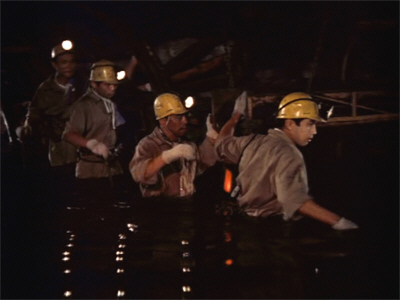
Suddenly, the creature reappears. It is soon clear that light machine-gun fire won’t do the trick either, and the soldiers retreat back up the shaft. It is Shigeru who comes up with a more effective plan: he sets in motion one of the mine’s metal rail-carts, fully laden with coal, and sends it speeding down the track at the creature which, dead or mortally wounded, falls back into the water. The men then advance again to try and retrieve Goro’s body.
Almost immediately, however, a chittering sound warns them of the presence of at least one more creature.
It is fairly clear that the Toho DVD release of Rodan was subtitled by a Japanese person with English as a second language. This results in a few glitches and typos on the way (including an important one we’ll deal with presently); and it also means that all the scrupulous Japanese politeness is retained in the dialogue—including at this moment, with Shigeru separated from the soldiers and in danger from the new creature, a situation to which he responds, “Please shoot now!”
But the main effect of the machine-gun fire is to set off a cave-in, which does kill the creature, but also traps Shigeru below ground…
Back at mining headquarters, both the press and the scientists have arrived. The latter is by far the most important detail—
Professor Kashiwagi [opening line]: “An amazing palaeontological discovery!”
—because our expert du jour is played by Hirata Akihiko, who would go on to appear in a remarkable number of the kaigu eiga, though always playing a different character. His first two such appearances could hardly be more different: in Gojira, as the tortured Dr Serizawa, with his eye-patch, his dishevelled hair, his lab coat, and his state of extreme angst, he was smoking hot; while here, immaculately neat in his buttoned-down suit and tie and horn-rimmed glasses – and, yes, his lab coat – he’s just adorably nerdy.
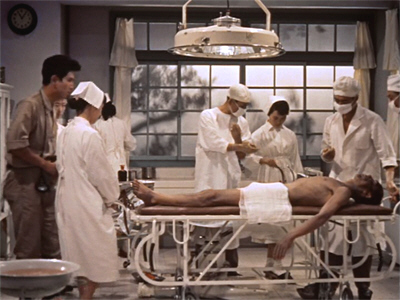
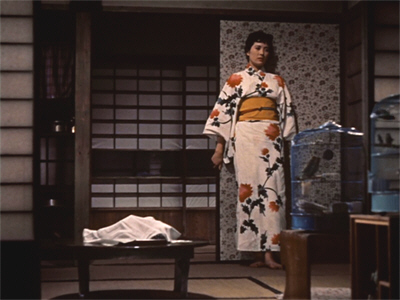
Professor Kashiwagi explains to the reporters – a number of them, but only Izeki from the Seibu newspaper will make his presence felt – that, in his opinion, the creatures are the larvae of the giant prehistoric dragonflies known as Meganulon. He further opines that Meganulon eggs were buried beneath the coal-bed; and that, between waves of diastrophism and shifting temperatures and humidity, the right conditions for hatching were eventually achieved. (Naturally, the case of the thousand-year-old lotus-seed is trotted out in support of this theory.)
The meeting is then interrupted with a bleak report to the head of the mine, that the searchers have been unable to reach Shigeru.
Bare moments later, an earthquake begins. Steam issues from a fissure on the slope of Mt Aso, while between the volcano and the mine, a huge subsidence of land occurs. The earthquake does not touch the mine badly, and Professor Kashiwagi is able to telephone through to Dr Sunagawa of the nearby Earthquake Research Institute. Sunagawa reports that the epicentre of the quake was between the mountain and the mine, and that it was shallow in nature.
The professor decides to inspect the area. He is joined by Sunagawa and a few of the reporters, as well as a police driver; but they soon find their way blocked by the collapse of the road. As they gaze around at the physical upheaval, Sunagawa observes with some confusion that this particular area did not register on the Richter scale.
Suddenly, Izeki cries out that there is a man in the depression. As the group stares down, the staggering figure collapses…
It is of course Shigeru. The others rush down to him and, in time-honoured fashion, treat his potentially serious injuries by shaking him up as much as possible. Izeki goes one step further, pushing for an on-the-spot interview. However, it turns out that the look of alarm which Shigeru turns on the reporter isn’t just for the obvious reason: in addition to his head injury, he has suffered a complete loss of memory.

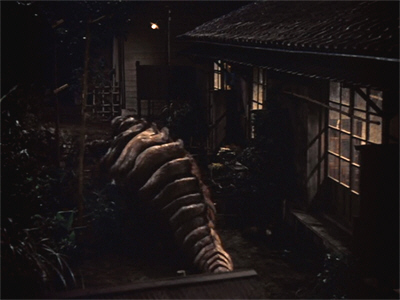
No-one is able to get through to him, not even the hastily-summoned Kiyo; and it is clear that in addition to amnesia, Shigeru is suffering from shock. He is hospitalised, and subjected to a series of tests and treatments to help him regain his memory, all to no avail. A photograph of one of the Meganulon gets some reaction, but it is not a breakthrough: rather, Shigeru develops a blinding headache.
Meanwhile, Nishimura, captain of the police force, is notified by the seismologists that there have been signs of eruption near the crater, and that the whole area must be placed under restricted access.
Rodan then abruptly jumps away from the relatively enclosed world of the mining community. At an airforce base, a pilot is reporting his sighting of – literally – an unidentified flying object, which he claims is travelling at supersonic speed towards Fukuoka (the largest city on Kyushu).
There is some clever compositing here, with the actors imposed upon a backdrop of an actual airforce base, and genuine footage of “Sabrejet” fighter planes. These were cutting edge in 1956, emphasising the capabilities of the mysterious object.
The pilot, Kitahara, is ordered to follow and continue transmitting updates; he does so, his first being an estimate that the object is flying one-and-a-half times as fast as his own aircraft. Alas, the situation rapidly turns tragic: the object changes course in a manner that should not be possible, if it actually is an aircraft; and Kitahara has only time for one cry of horror before it collides with his plane, which breaks into pieces.
We, however, do get one quick look at it…

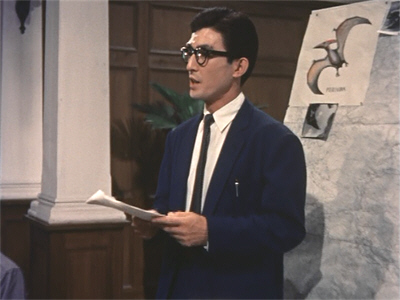
Even when the wreckage – including a gruesomely blood-splattered helmet – is recovered, the senior airforce personnel are unable to explain the incident; though the 2iC helpfully suggests that the object was, “A flying saucer or a foreign secret weapon”…in that order.
There is a phone-call for Izeki the reporter, who learns that contact has been lost with a British passenger-plane. This is, in its oblique way, an important moment: though the object will be tracked across the skies over China and the Philippines, inevitably it is only Japan that suffers from its subsequent actions, even though it can (presumably) travel anywhere in the world that it chooses. This moment is the only exception to this rarely violated science-fiction rule.
It is actually the Chinese who first suggest that the object might be “a monster”; though their second guess is also “flying saucer”.
A report from Tokyo indicates that the object has left “catastrophic damage” in its wake, thanks to its ability to create “destructive shock waves”, though no-one has come any closer to getting a good look at it. Another report from Okinawa suggests the object might be returning to southern Japan—though when the various sightings and areas of damage are taken into consideration, it is realised that whatever it is, there must be more than one…
We then get another abrupt jump to perhaps the oddest subplot in Rodan: a newly married couple decide to start their honeymoon by visiting the restricted Mt Aso crater (!), the groom explaining that he has a friend at the volcanological lab (this would be Dr Sunagawa; what the hell was he thinking!?). Once at the site, the bride poses and smirks while her new husband photographs her; but the smirk is wiped off her face when something swoops low across the area, creating a fatal shock wave.

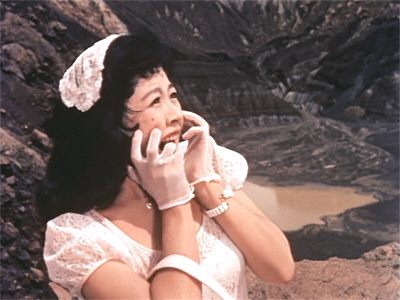
Horribly, the tragedy is at first interpreted as a double suicide (on their wedding-day!?). However, when the film from the camera is developed, it not only throws a different light on the couple’s activities, but offers the first indication of what the mysterious flying object actually is. In another of Rodan’s less believable touches, a blurry camera-image just happens to fit exactly across a sketch of a certain flying prehistoric creature…
Here the glitches in the Toho subtitling do intrude, as this word is misspelled “Petranodon” throughout—muddying some important waters. Today of course we invariably think of Rodan as “Rodan”, but at this first appearance the creature is actually dubbed Radon by Professor Kashiwagi.
This is explained simply as being short for “Pteranodon”, but of course it carries a secondary meaning all too perfect in context, that of radon being a radioactive element. Strangely enough, this seems to have been the problem in America, prompting the change to “Rodan”, though whether to avoid confusion or as yet another instance of removing from these films negative references to the atomic bomb and related issues, I am not certain.
In fact, the professor is hesitant at first to conclude that the “flying saucer” is a Pteranodon, as the fossil record suggests these creatures grew no bigger than a wingspan of some twenty-eight feet. Izeki cites cases of horses and cattle disappearing from the vicinity of Mt Aso, while Kashiwagi’s colleague points out that Pteranodon and Meganulon were from the same prehistoric era. The professor still resists the conclusion on such relatively slender evidence, observing that they may know for sure if Shigeru recovers his memory. He is still in the hospital, where Kiyo takes care of his general needs—though he remains unresponsive to her.


Presumably in an effort to make his room more cheerful, Kiyo has brought her own pet birds to him, and now points out to him that they have laid eggs in their artificial hanging nest. Gently, she removes the latter from the cage and places it in Shigeru’s hands. As he stares down into the relative darkness of the nest at the two tiny eggs in its depths, one of them begins to move—and then cracks open. And finally, something stirs in Shigeru’s memory…
We flashback to the cave-in. As Shigeru staggers to his feet, he finds himself in a huge underground cavern (with surprisingly good lighting). He sees first a whole clutch of Meganulon, and it is while he is putting some distance between himself and them that he finds himself confronting a gigantic egg. As he stares, the object begins to rock back and forth, and then cracks open—revealing an enormous, leathery, winged creature.
As Shigeru watches, the creature begins feeding upon the Meganulon—reducing these creatures, so large and frightening to Homo sapiens, to the level of, well, insects…
(This is an immensely clever way of making the viewer feel the size of Rodan.)
In the present, Shigeru is in a state of extreme, sweaty terror—but he has his memory back. Examining the various sketches that Professor Kashiwagi offers him, he immediately picks out the Pteranodon as the creature that he saw.
The next thing we know, Shigeru is leading a search-party back into the mine. The men find the nesting area, although the subsequent collapse of the ground during the earthquake has buried most of the evidence (and presumably the remaining Meganulon). Shigeru and the professor do find some shell fragments, from the curvature of which the latter is able to calculate the size of the egg. Analysis determines that the shell is made predominantly of calcium, and is in every respect comparable to a modern bird egg.


Addressing a meeting of military higher-ups and reporters, Professor Kashiwagi asserts that the creature, now dubbed “Rodan”, has a wing-span of approximately 270 feet. (Though in reality, as with all of the kaiju, the creature’s dimensions will fluctuate as required, scene by scene.) As for Rodan’s origins, well…
Professor Kashiwagi: “I can’t be sure of how, but I can think of one possibility: that it is the result of nuclear bomb testing…”
Mind you—he does not suggest that radiation created this freakishly large Pteranodon (and the Meganulon), only that it woke the creature up.
A team is constructed to examine the line of the earth collapse. (We see that, when in the field, Kashiwagi lets himself go—taking off his tie, undoing his top button, and wearing a dorky hat.) As they approach the area in question, there come the sounds of yet more rock-fall—plus a strange cry. The men hurry up an overhanging ridge, just in time to see Rodan emerge from its underground retreat…
(“That’s it, I’m sure. I saw it in the cave!” exclaims Shigeru…as if there could be some question of identification.)
Rodan takes off and flies away; and we get our first good look at the creature’s inherent destructive force, as the unfortunate soldier sent back in a jeep to “alert headquarters” has his vehicle swept off the road and slammed into some rocks by the force of even its gliding flight.
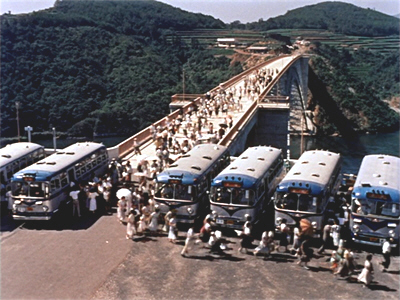

Fighter jets of the JASDF are scrambled—accompanied by one of Ifukube Akira’s martial themes. (There is relatively little music used in this film, and most of that low-key.) An air battle follows, during which two of the planes are lost. The leader of the squadron reports that Rodan is headed towards Sasebo (another city on Kyushu Island, in the Nagasaki Prefecture), where the residents stare up into the skies, aghast, and terrified tour-groups flee the Saikai Bridge.
The battle continues, and at first it seems as if the fighter pilots may have been victorious: subjected to constant fire, Rodan drops from the sky and disappears into the waters at the base of the bridge. The pilots follow up their advantage, coming in low and sending more fire into the waters. Their hopes are soon dashed, however: Rodan re-emerges, and then it is they who are being pursued and attacked. The creature swoops low—and as it passes, the Saikai Bridge buckles and collapses…
This scene offers our first really good look at Rodan: close-ups, so that we can see both the pros and cons of the suit, and the suit-work. The good news is that it is again Nakajima Haruo inside the suit, and his performance is as enthusiastic as we would naturally expect. (Lots of wire-work for Haruo this time around…and one bad fall, when the wire broke during the Saikai Bridge sequence.) The suit itself is, however, not as thoughtfully designed as we might wish: the wings are curvy single sheets, rather than properly articulated as they should be, if Rodan is a Pteranodon (though that said, this design was probably based upon the early idea that Pteranodons flew chiefly by gliding, rather than flapping); nor is the lengthy, toothless beak present. That Rodan is bipedal is understandable – debate on that point was longstanding, though there now seems to be consensus that Pteranodons were quadrupedal – and that is not my problem with the creature design, but rather the two thick, rather stumpy – and distinctly humanoid – legs projecting from beneath the body.

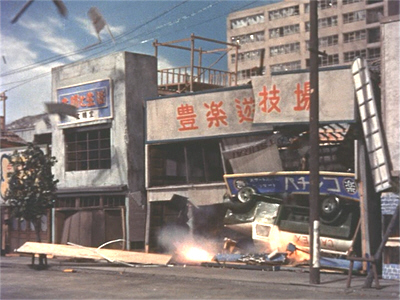
Though Rodan continues on its way, it has been wounded; the squadron leader reports that its air-speed has been reduced by half as it flies towards Fukuoka, where evacuation is underway.
And it is Fukuoka that gets—well, there is some stomping, but mostly it gets waved.
Like Rodan, the set-piece destruction of Fukuoka is a slightly mixed bag. There’s no question that with colour photography, the model-work is much harder to disguise, particularly with respect to the real origins of the army tanks, and the emptiness of the collapsing buildings; while in many instances the compositing is very obvious. Most damaging of all, this is also true of the wires by which Rodan is manipulated during the fight and flight scenes. There is also, in my opinion, too much army and not enough collapsing buildings.
On the other hand, the attention to detail in this scene – the extent to which real areas of the city, and real buildings, were reproduced – is remarkable; and this is highlighted by such touches as the destruction of the Asahi brewery, which was and is located in Fukuoka.
We should mention one iconic moment here: that shot of a soldier, being blown away, who tries to save himself by clutching at a tree; a shot which in the future would become a much re-used piece of stock footage. There is also an amusing detail – could it possibly be product placement? – when what is explicitly a Caltex truck slams into a building and explodes.
In fact, the way that the film-makers went about all this suggests that, as early as the third film in the kaiju eiga series, it was already becoming something of a badge of honour for a city to be wiped out by a monster. While this is perfectly understandable from an external perspective, it does point forward to the less serious kaiju eiga films of the late sixties. We also note a distinct shying away from large-scale human casualties, with Fukuoka evacuated in an absurdly short period of time.


The army is sent out into the streets of Fukuoka to surround Rodan and subject the creature to sustained crossfire. Though the city suffers appalling destruction, it seems for a time that the military might actually prevail—
—until a second Rodan shows up!
It is natural – and understandable, particularly given how this film ends – that the two Rodans are usually interpreted as mates. But if we think about it, we can see that they must, rather, be siblings; nest-mates, rather than a bonded pair. And one of the consequences of this is that we cannot know what sex either one of them is…which is why I’ve been saying “it” and “the creature” instead of “he”. Rodan does tend to be read as male, though; and going forward, I’ll probably cave on that point…
Be their relationship what it may, there is no doubt that the second Rodan has come to the rescue of the injured first one, by drawing the army’s fire. The two of them fly away together, leaving behind them a city in ruins and on fire…
Afterwards, the creatures cannot be located. Professor Kashiwagi believes that they have probably returned to the Mt Aso area, where they were hatched. He leads a helicopter expedition – rather you than me, professor! – over the area, and sure enough, the Rodans are spotted in a crevice near the crater of the volcano. A plan is formulated to subject the crater with missile bombardment in the hope of burying the creatures.
Dr Sunagawa protests this plan, believing that it will likely trigger an eruption—to which the military response is, “All the better.” Sunagawa continues to object, not to the damage done to “his” volcano, but because of the resulting destruction of the surrounding forests and farming-lands. The officer in command replies that, of course, all residents will be evacuated first; but between the damage caused by an eruption and the potential, ongoing destruction that might be caused by the Rodans, there isn’t any choice…

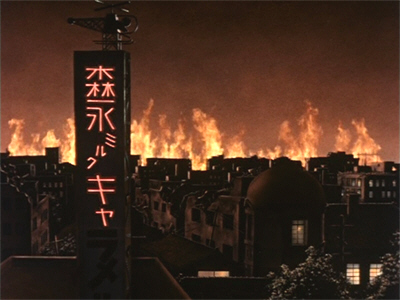
So the bombardment begins, and achieves the desired result: the surrounding land collapses and caves in, and Mt Aso erupts.
Driven from their refuge, the Rodans try to fly away; but the first one, the injured one, cannot escape: it stutters in flight and falls to ground—where it contacts the lava and is incinerated.
The second Rodan circles overhead for a time…then flies downwards, settling upon the lava and immolating itself…
As I said earlier, this is usually interpreted as the second Rodan being unwilling, or unable, to go without its mate; but if it is, rather, the last Rodan alive choosing not to go on alone, it is certainly no less depressing.
While I do not, at this time, feel much warmer towards Rodan than I did at the outset, I think I appreciate it a little more, or anyway certain aspects of it. In particular, the choice of the unfamiliar (to western audiences) territory of Kyushu Island as the setting for this film, and the location filming around Mt Aso, and in Fukuoka and Sasebo, gives a wonderful atmosphere to the production, and also a sense of integration to the story as a whole. The film’s use of aerial photography plays an important part in this.
Furthermore, as is always the case with the works of Honda Ishirō, the first section of Rodan has a real humanism about it, with time taken to linger on the details of life in the mining community. Despite the interpersonal feud that sets the plot in motion, what we take away here is the mutual support amongst the miners and their families, and – more unexpected, but very welcome – the constant concern expressed by the head of the company, not for his mine, but his workers. When bodies begin to be discovered in the mine, we feel the horror and grief of the survivors—but also a sense of betrayal, that such a thing could have happened in this “family”.


And of course, as the crisis evolves, there is the automatic banding together of the people tasked with handling the crisis.
Yet in a way, the latter is also one of my problems with Rodan: there is a lack of tension in the film, with the plot moving smoothly from one point to the next—and with the titular menace defeated by the first thing the military tries!
Then, too, we don’t hear nearly enough from SCIENCE!! in this film; nor does Professor Kashiwagi ever give any indication of a save-it-for-science attitude, in spite of his initial enthusiasm for this, “Amazing palaeontological discovery!” Rather, the professor spends the whole film comfortably hand-in-glove with the military as they seek for ways of destroying these living fossils; and it is left to second-banana, Dr Sunagawa, to voice the only objection.
The film’s almost throwaway reference to “nuclear bomb testing” also illustrates this imbalance: there is a token feel to Kashiwagi’s remark that we might expect much later in the kaiju eiga cycle.
Another shortcoming of Rodan is a lack of outstanding characters. The cast generally is colourless, the presence of Hirata Akihiko notwithstanding; and though Sahara Kenji would of course go on to an equally long career in this sort of film, he was very young and inexperienced when he made this one, his first. Too often, the people who should, or anyway could, be our identification figures – Shigeru, the professor, even Ikeki the reporter – are found simply tagging along in any given scene, and contributing little if anything; distinguishable from your average Kenny only by virtue of their long pants. (And don’t get me started on Kiyo…)
Nor do the film’s monsters entirely compensate for this lack. Don’t get me wrong: I love both Rodan and the Megnulon; but we don’t see enough of either of them, compared with the human cast. In fact, it is fully 55 minutes into this 82 minute film before Rodan gets properly into action.
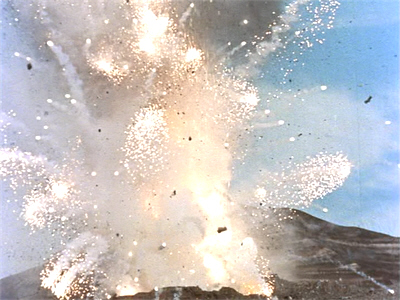

Perhaps this delay can be attributed to an uncertainty about what to do with the Rodans, particularly after Godzilla set the bar so high. There seems to be an absence of proper think-through with regard to the creatures’ behaviour—including their destruction of Fukuoka.
When we consider the other kaiju, this is not the case. For example, Godzilla’s stomping of Tokyo is both immediately motivated and organic to the conception of the creature; while at the other end of the spectrum, Mothra too causes damage by her wing movements—but entirely inadvertently, meaning no harm. The Rodans seems to have been dropped rather haphazardly between these two extremes. I suppose we can conclude that Rodan-1 destroys Fukuoka because he is injured and pissed off; but while that’s a valid motivation, it does rather lack gravitas.
But having pondered the matter, it is the ending of Rodan that makes me harden my heart towards it—not just because of how painful it is, though it is very painful, but because here the sense of imbalance in the film takes centre-stage.
I am aware of just how unfair it is to draw comparisons between Gojira and—well, anything else, really. The fact remains, that film is the supreme example of this sort of thing done correctly. Its ending is prepared for with great care, and forms a fitting climax to a story of great emotion, as well as great drama. Here, however, the generally muted tone and the much greater focus on action means that the brutal ending of Rodan comes too much out of the blue—and this, finally, is my overarching objection to the film: that it is upsetting, without having properly earned the right to be so upsetting.


♦♦♦♦♦♦♦♦♦♦♦♦♦♦♦♦♦♦♦♦♦♦♦♦♦♦♦♦♦♦
But there is, of course, more…
♦♦♦♦♦♦♦♦♦♦♦♦♦♦♦♦♦♦♦♦♦♦♦♦♦♦♦♦♦♦

“Just one thing more: though related to the Pteranodons, this creature is a carnivorous reptile, and belongs to a species called ‘Rodan’…”
In 1957, Rodan was picked up for American distribution by King Brothers Productions, and had a highly successful run in general release.
The film was handled for the Kings by the Distributors Corporation of America, a factoid that might send chills down the spine of knowledgeable kaiju watchers: this was the company that, in 1958, turned Honda Ishirō’s sombre and serious Jū Jin Yuki Otoko (Beast-Human Snowman) into the risibly awful Half Human.
Thankfully, Rodan is more towards the Godzilla, King Of The Monsters end of the scale: still tampered with, but not dumbed down, and not subjected to the same sort of disrespectful “Americanisation” either…at least, once we get past the opening sequence.
Here, we find a tacked-on – and tacky – piece of stock footage dealing with H-bomb testing: evidently no-one saw a problem with a glorification of the weapon being inserted into a Japanese film; though it does finally give way to a burst of what-hath-Man-wrought, couched in the absurdly flowery language we’ve already learned to expect from these sorts of things:
Narrator: “But what have these tests done to Mother Earth? Can the human race continue to deliver these staggering blows without arousing in the depths of Earth a reaction, a counterattack, a horror still undreamed of? There are persons in the Japanese Islands who believe that the horror has already been seen. What is the aftermath? This is the story of one such aftermath…”
It is strange that after as much of the atomic-bomb metaphor as could be was stripped out of Gojira, in turning it into Godzilla, King Of The Monsters, the American handlers of Rodan did exactly the opposite here, forcing a nuclear reading on a film that shies away from it.
The English-language version of Rodan was written by David Duncan, while the general narration, including the opening sequence, is by Art Gilmore.
I say “general narration” because this version is largely told from the point of view of Shigeru—with Keye Luke doing double-duty as dubber and narrator. And while this isn’t as relentless, or as circumstantial, as the narration later imposed upon Gigantis, The Fire Monster, it still gets hard to take at times.
Meanwhile—a young George Takei got his first acting job dubbing Hirata Akihiko’s Professor Kashiwagi: a collision of such mind-bending coolness that I’m surprised it didn’t rupture the space-time continuum.
But that wasn’t his only job: all of the dubbers here pulled multiple duties, including – inevitably – Paul Frees.
The American Rodan is ten minutes shorter than its Japanese counterpart, which means that if we take into consideration the four-minute-plus stock-footage opening, only sixty-eight of its original eighty-two minutes remain. No really large cuts or changes have been made, but the human interaction has been pruned back and the general action speeded up, in order to get to the “good bits” more quickly. There are also more “good bits”: the film has been re-edited so that the second Rodan appears earlier, and plays a more significant role. The dimensions of Rodan have also been considerably exaggerated to an absurd, 500-foot-wide wing-span.
While it generally follows the Japanese plot, perhaps the most important tweak in this version is that “Rodan” is made a species of pterosaur, rather than just being the name given to this this particular specimen. (You can kind of see their point: “This terrible monster that is destroying the world – we have named it ‘Algernon’…”)
A more subtle bit of tampering comes later, with the setting of the main Rodan attack changed from Fukuoka to Sasebo—apparently because various American diplomatic services were situated in the former! Alas, it doesn’t seem to have occurred to anyone that sticking with Fukuoka would have neatly bookended the opening “What have these tests done?” speech. (On the other hand, I’m inclined to wonder whether that wasn’t the reason the film-makers chose Fukuoka in the first place!)
Overall, however, if we can ignore the imposed opening, Rodan probably suffered less at the hands of its American distributors than any other of the imported kaiju eiga, or at least of this first crop of them. Above all, no Caucasian actors, no explicitly American subplots, were forced upon the existing story, in that exasperatingly condescending manner that afflicts some other of these films—insulting to Japanese film-makers and American audiences alike.
As it stands, the main fault of the Americanised version is that too much of the dubbing is done in that exaggerated, slightly cartoon-ish manner that for some reason was associated at the time with Japanese speech. Again, it’s not as bad as in Gigantis, but it’s enough to mar the film’s serious tone.
Finally—I can’t close this without admitting my wry amusement at the fact that the distributors, too, evidently found something unsatisfying about the ending of Rodan…and reacted by going completely overboard.
How about this for a closing speech?—
“As Kiyo-chan turned to weep on my shoulder, I realised the Rodans were doomed. The heat, the gases, the bombardment added to their bewilderment. Like moths, in those rivers of fire, they seemed almost to welcome the agonies of death. And when, still calling to each other, one of them fell at last into the molten lava stream, the other still refused to save itself. The last of their kind, masters of the air and earth, the strongest, swiftest creatures that ever breathed—now they sank against the earth like weary children. Each had refused to live without the other, and so they were dying together. I wondered whether I, a 20th-century man, could ever hope to die as well. It was if something human were dying, as the flames consumed them in a fiery holocaust, their last agony wail echoing in a mournful cry. I stood there staring with a strange fascination. I realised that, by the narrowest of margins, mankind had proved himself the stronger. But will it always be so? May not other, and even more terrible monsters even now be stirring in the darkness? And when at last they spring upon us, can we be certain that we shall beat them back a second time? The answer lies in the future. Our fears for now have gone up in flame and smoke…”
Yes, yes; lesson learned: Japanese understatement before American overstatement every time…

Want a second opinion of (the Americanised) Rodan? Visit 1000 Misspent Hours – And Counting.

Too bad that final speech from the American version wasn’t done by George Takei.
LikeLike
That would definitely have torn the space-time continuum a new one! 😀
LikeLike
Maybe if we ask him nicely?
LikeLike
I think my favorite title version for this is the Spanish one – The Sons of the Volcano
LikeLike
They inference being, they assumed that both Rodans were male?
I’ve caught myself saying “Il Mostro Alato” quite a lot.
LikeLike
‘los hijos’ could be both male, or one male and one female. the masculine gender is used if any of the subjects are male.
Not fair, I know.
LikeLike
Ah! I didn’t know that, thanks.
LikeLike
Long time follower, first time commenter! I really enjoyed your analysis and comparison of the original and US versions of the movie. Whenever I’m watching a strangely dubbed Japanese film, I wonder how much of the goofiness comes from the original vs. the English “translation.” I haven’t seen Rodan in many years and I have to admit that it was never one of my favorite kaiju films. Even as a kid, I knew that end narration was way over the top; it’s good to know that it wasn’t in the original. However, I guess the movie just…stops abruptly in both versions.
George Takei!
LikeLike
Welcome! Thank you for visiting, and for your comments. Of course we now know we’re talking about two different sets of issues with the two different versions. I’m increasingly getting the feeling with the US versions that it is a case of “American film distributors abhor a vacuum”, as if they felt the need to fill any silence with babble.
Very much George Takei! 🙂
LikeLike
The comments on original vs English versions reminded me, I was just watching Dogora on Amazon the other day. I had the closed captions on and like so many of these films a different team did the translating for the closed captioning apparently using the original Japanese version. The dialogue in the captions was completely different and made a lot more sense than the English dub dialogue.
LikeLike
Personally, I love the movie. Even as a kid, I loved the slow build-up, and found the ending tragic and powerful. Admittedly, I haven’t seen it in many years.
LikeLike
Well, don’t let me dissuade you: you’ll see below that you have the Rev in your corner. 🙂
LikeLike
Oh, a giant monster movie review from Lyzzy! My heart, it is glad!
This was my second or third kaiju eiga (I can’t recall if this or Godzilla vs. Megalon came first). I may have more affection for it than it deserves due to that. Still, it has strong enough human elements that I didn’t fast-forward to the “good stuff” when I was younger. I also adore the Meganulon enough that I don’t mind waiting for Rodan to show up. I love the various flying creatures of the past, so naturally Rodan is a favorite of mine, uneven physical appearance notwithstanding. The sequence with the three men being killed in the mine absolutely terrified me as a kid, and the pair of legs sticking out of the jeep as it smashes into that rock also unsettled me (nowadays I tend to giggle or shout “G.I. Joe, nooooooo!” or something), as did the fates of the various pilots. As a kid, the ending speech fascinated me; today, it just gives me the warm fuzzies. Looking at it objectively, I can understand your cold-heartedness towards it, my dear, even if I don’t share in it.
As a bonus, since a friend of my dad’s taped it for me off of TBS, I had Al Lewis hosting it for their “Super Scary Saturday” program, and it ended with the “Top Creature” music video, which was footage from the movie edited together with a certain Kenny Loggins song playing over it. I absolutely loved that. I sadly can’t seem to find it online, which makes me wonder if I’ve still got that tape…
LikeLike
If I’m still not giving you what you want, at least I’m giving you something, right? 🙂
I feel like it needed to have a bit more substance…or a bit less substance. Does that make sense? It’s good that it’s serious, but in being so, it’s too content to sit in the shadow of Gojira.
LikeLiked by 1 person
I HAVE NO IDEA WHAT YOU ARE REFERRING TO
I understand what you mean, and I don’t view it as fondly as I did when I was younger, but it has enough memories for me to not be able to come down on it as hard as it perhaps deserves. At least it holds up better than my first, which was Godzilla 1985.
LikeLike
I loved this as a kid, both because I loved monsters AND I loved pterosaurs (still do!). I watched it a few years ago as an adult because I was doing research on giant bugs in movies, and discovered I didn’t like it nearly as much. The third act is just…kinda boring! That long distance shot of Rodan, (clearly just footage of a jet plane), is used way too much. Too much time is spent on people talking about how big and fast Rodan is and too little showing us. The problem is the size of it, it can’t smash buildings like Godzilla, it has to blow things over by flapping his wings. There’s only so many time you can see that before it gets old. As a monster, pterosaurs work better at a smaller scale. A flying creature that can snatch you off the ground is terrifying in a personal way. A monster that destroys you with a sonic boom or creating wind is interesting, but not exactly nightmare material.
LikeLike
Yes, I pretty much agree with all that. I would add that, as I said, there’s too much army. And that’s a real issue: it’s too much of a fair fight. Granted, conceptually pterosaurs ought to be more fragile but it’s still kind of a bummer. 🙂
LikeLike
Y’know, I guess I always assumed that the two Rodans were somehow born fully grown, which doesn’t make much sense. If the hatchings are this size, imagine how big they’d be as adults…
LikeLike
Maybe I’m doing the US version an injustice: they hatch at a 270-foot wingspan and grow to a 500-foot wingspan. 😀
It’s a fair point; not one that is at all addressed. That we’re dealing here with something hatching, not something being woken up. And perhaps my remarks above about the relative fragility of Rodan should be reconsidered in that context?
LikeLike
Like you, I was never very impressed with this, relative to other kaiju films, even as a kid. And now I’m discovering that I actually have no memory at all of the film’s first half! Guess it was pretty forgettable despite the dragonfly barging into someone’s house.
LikeLike
It’s almost two different movies hinged in the middle, and they don’t have all that much connection. Though if anything, it’s the Meganulon stuff that brings something new to the table.
LikeLike
At the risk of sounding all [citation needed], where do you find all the tid-bits about the making of the movies, the history of the suits, and so forth?
LikeLike
I have a lot of books. 🙂
When a film deserves it I do a lot of reading around it before I write anything (which is one reason new reviews take so long). This time I had plenty of Toho general knowledge but didn’t know about the film’s setting and its history, or about the mine.
LikeLike
The Rodans’ fate seems to have influenced the latest run of Gozilla/Mothra/Destroy All Monsters movies–particularly the first one, where the nesting pair lose their egg.
LikeLike
A movie about a couple who commit double suicide on their wedding day would I think be a lot more interesting (and, for that matter, more horrifying) than “Rodan.”
LikeLike